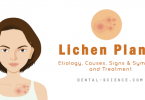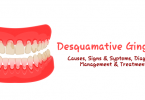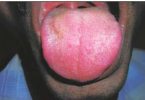Denervation Atrophy
Epidemiology
- Adenocystic and squamous cell carcinoma of the head and neck have a propensiry for perineural infiltration.
- Because the masticator space has no mucosal surface, malignant spread along the mandibular nerve is seen in tumors that have invaded this space.
- These tumors usually originate in the adjacent visceral spaces such as in nasopharyngeal and oropharyngeal cancers.
Clinical Findings
- The primary disease usually overshadows symptoms and signs of early perineural spread along the mandibular nerve.
- Perineural infiltration of the mandibular nerve results in denervation atrophy of the masticator muscles resulting in trismus.
- Atrophy of the temporal is and masseter muscles is often visible on inspection.
- Trigeminal neuralgia, however, may be a prominent symptom when perineural infiltration of the mandibular nerve extends ro the trigeminal nerve.
Pathology
- Changes in the skeletal muscles following denervation can be divided into three phases: acute, subacute, and chronic.
- Animal models show that in the first 4 weeks, there is a decrease in the caliber of muscle fibers but no change in the total amount of tissue water.
- There is, however, a relative decrease in intracellular water associated with a relative increase in extracellular water.
- In the chronic phase, muscular atrophy associated with fatry infiltration takes place.
- A mixture of features seen in the acute and chronic stages characterizes the subacute phase. In addition, there is a relative increase in the perfusion of muscles following denervation.
Treatment
- Involvement of the cranial nerves in nasopharyngeal carcinoma is T 4 disease.
- All head and neck tumors showing perineural infiltration with intracranial extension carry a grave prognosis.
- Hence the identification of perineural infiltration is crucial so that appropriate therapy can be institured.
- Surgical treatment is directed at excising the primary tumor along with adjacent structures affected by tumor infiltration.
- Postsurgical radiation therapy may be given depending on the status of surgical margins and proximal intracranial exrension.
- The mainstay of treatment for nasopharyngeal carcinoma is radiation therapy.
Imaging Findings
CT
- In the acute ro subacute phases, CT may be unremarkable compared with MR findings.
- However, in the subacute to chronic phases, the muscles of mastication (medial and lateral pterygoids, masseter, and temporalis muscles) show a decrease in bulk in association with low attenuation as a result of fatry infiltration
MR
- In the acute to subacure phases, T2-weighted images show high signals thus producing an edema-like appearance.
- This is because the T2 of extracellular water is longer than the T2 of intracellular water.
- In addition, there is a relative increase in perfusion and increased accumulation of contrast in the extracellular spaces in denervated muscles resulting in increased contrast enhancement.
- The chronic phase is characterized by muscle atrophy and increased signals on T l and fast spin echo T2-weighted images due to fat accumulation
Imaging Pearls
• The mylohyoid nerve, a branch of the mandibular nerve, supplies motor fibers to the mylohyoid muscle and the anterior belly of the digastric muscles. Attophy of these muscles in the floor of the mouth is best seen on cotonal MR images.
• Contrast enhancement of the muscles of mastication may be confused with tumor infiltration. Tumor infiltration is associated with the presence of mass effect. Denervated muscles either are normal in caliber or show atrophy.
• It is important to examine the entire course of the trigeminal nerve. Tumor may extend proximally to the route entry rone of the trigeminal nerve.
ــــــــــــــــــــ►ⒹⒺⓃⓉⒶⓁ–ⓈⒸⒾⒺⓝⓒⒺ◄ــــــــــــــــــــ







